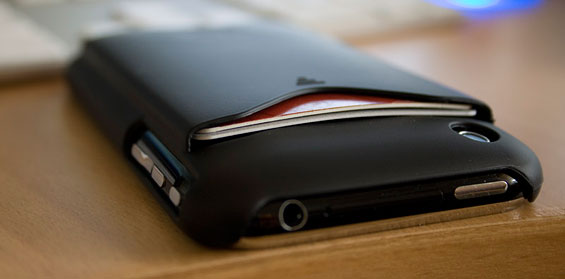Around every 10 or 20 years, something big comes along that completely transforms the world of banking — ATMs, debit cards, the internet. Unquestionably, the next big thing to rock banking will be mobile wallets.
“Money” and “mobile” are on an irreversible collision course. Consider what we’ve witnessed in the last five years alone. Mobile banking has taken off. Consumers can use cameras on their phones to deposit checks and pay bills. Folks are using mobile Facebook apps for common, casual payments — reimbursing a friend for lunch, or paying the babysitter. And some are already using phones to make purchases at brick-and-mortar retailers.
Just to be a clear, a “mobile wallet” — defined at least for financial purposes — allows consumers to store and manage their credit, debit, prepaid and gift cards on their smartphone using a singular payment application. Instead of carrying around a stack of physical plastic cards, consumers can use the virtual “cards” on their phone to make point-of-sale purchases. They can swipe of their phone or tap the screen a few times, and voilà — a payment can be easily made. (Note: the definition of “digital wallet” is often expanded to include nearly every piece of information consumers carry around with them today — government-issued IDs, driver’s licenses, health insurance cards, etc.)
Reality Check: Mobile devices are the future of payments, and mobile wallets represent much more than just an emerging/alternate option. Soon nearly 100% of all transactions will be 100% digital, and consumers will be able to conduct and manage nearly every one of them through their mobile devices. Mobile wallets will consummate a new era in banking.
One needs to look no further than the success Square has enjoyed to see the promise and potential of mobile payments. This startup has completely revolutionized credit card payments, particularly for small businesses. Now, thanks to a simple one-inch square attachment that plugs into an iPhone’s external headphone jack, consumers can swipe their cards at more locations than ever before. Today Square is worth over $3 billion, and it isn’t even three years old.
And Square is just scratching the surface. The collective leap to mobile wallets — where the payer uses their phone instead of the merchant’s — is just around the corner.
Are Consumers Ready for Mobile Wallets?
Researchers found that only 27% of all consumers and nearly half of smartphone users (44%) report overall interest in being able to use their smartphone to process in-person payments.
Enthusiasm is tepid however, with only 8% saying they are keenly interested in seeing mobile wallets on their phones soon.
Just over half of those not interested (52%) indicate that they simply don’t see any reason to switch from cash or plastic cards.
Another 12% indicate that they have already either used a mobile wallet to make payments themselves (4%) or witnessed it firsthand (8%).
Among those who indicate being either not very or not at all interested in being able to make smartphone payments, security is a clear, if predictable, factor. Half say they don’t want to store sensitive information on their phone, and four in ten don’t want to transmit sensitive information to a merchant’s device.

If consumers think they aren’t ready for mobile wallets yet, then why are they buying iPhone cases to hold their credit cards?

The Financial Brand Forum Kicks Off May 20th
Explore the big ideas, new innovations and latest trends reshaping banking at The Financial Brand Forum. Will you be there? Don't get left behind.
Read More about The Financial Brand Forum Kicks Off May 20th

The Power of Localized Marketing in Financial Services
Learn how to enhance your brand’s local visibility, generate more leads, and attract more customers, all while adhering to industry regulations and compliance.
Read More about The Power of Localized Marketing in Financial Services
Okay, So When Will Mobile Wallets Rule the World?
That’s a trillion dollar question, isn’t it? It’s hard to say, but you can definitely rule out mobile wallets ruling the world anytime in 2013. Probably not next year either. But by 2015? Maybe.
RSR Research says 20% of retailers expect some form of digital payment (including mobile) will be their customers’ primary payment method in three years’ time.
“It’s clearly going to happen,” says Michael Becker, a managing director with the Mobile Marketing Association. “But an end-to-end system will be needed. All the parts will have to come together to create mass-market consumption, and that could take 12 to 24 months at a minimum.”
Harris Interactive says six in ten consumers believe smartphone payments will eventually replace both payment card (66%) and cash (61%) transactions for a majority of purchases. However, while many Americans perceive this change in payment culture as a likely eventuality, considerably fewer appear to perceive it as imminent. Only 32% believe this will happen in less than five years.
But when mobile wallets do start to gain real traction, things are going to move very quickly. Just look how long it took consumers to embrace online payments. They went from “I’ll never buy anything online” to “I prefer shopping at Amazon” in less than 10 years. Mobile wallets could take off in half that time. After all, there are now nearly as many mobile phones on the planet as there are people.
Consumers Want Mobile Wallets…
Whether They Know It or Not
Harris Interactive says consumers won’t change how they pay simply because a new technology allows them to do so. Financial marketers need to articulate a meaningful value proposition, and they concede that even their own research might not be particularly helpful.
 “When debit cards came to prominence, they did so by responding to a genuine consumer desire, even if consumers weren’t aware of that desire until the solution presented itself,” the team at Harris Interactive noted.
“When debit cards came to prominence, they did so by responding to a genuine consumer desire, even if consumers weren’t aware of that desire until the solution presented itself,” the team at Harris Interactive noted.
Another way to say it: Consumers are already interested in mobile wallets. They just don’t know it. Yet.
No matter what consumers today say they think of mobile wallets today, mobile wallets will triumph. Why? Because mobile wallets will simplify consumers’ lives in very personal and relevant ways. For starters, they eliminate the nuisance of thick, cluttered wallets. They also reduce the transmission of germs, because they eliminate plastic cards, pens/signatures, touchscreens and keypads.
But ultimately consumers will come to appreciate the combination of convenience and real value mobile wallets can deliver.
For instance, consider this mobile wallet scenario.
You’re out shopping at one of your favorite local stores. You scan a bar code on an item that interests you. The wallet knows the price and where you’re at, so it might suggest another store where the item can be purchased for less.
If you decide to buy the item, you could proceed with the purchase right there on the showroom floor — no need for a cashier, just press the “Buy Now” button and walk out the store. So you decide to use your mobile wallet — loaded with several cards from multiple financial institutions — to make your purchase.
The wallet app helps you determine which payment card should be used for this particular transaction. First, it rules out any cards that might incur extra fees (e.g., those over credit limits, or foreign exchange fees). The wallet also checks to see if any special coupons and discounts might apply if a particular card is used. It can calculate the value of bonus programs and recommend the card offering the most value (e.g., 2x points for purchases made through certain retailers). And it can even optimize your float by putting the purchase on the card that has most recently been cycled.
Brilliant! Now who wouldn’t want that?
Alas, mobile wallets have a complicated value proposition to convey. That’s why, for the time being, consumers only see mobile wallets as a new method of payment and nothing else. With their limited understanding, consumers frame the issue in simple, existing terms they can relate to today: “Cash, credit or phone? So it’s one more choice? Whatever man.” They don’t understand the full potential nor the benefits. This is why research attempting to gauge consumer interest in mobile wallets should be approached with some degree of skepticism. They don’t get it.

What Can Financial Marketers Do to Prepare for Mobile Wallets?
Carlisle & Gallagher Consulting Group believes mobile wallets represent a real threat to traditional financial institutions, saying that banks and credit unions alike risk losing relationships with customers and their PFI position if non-bank competitors are allowed to dominate the mobile wallet space. They urge financial institutions to update their core transaction processing capabilities to align with the requirements and expectations of the 21st century.
Carlisle & Gallagher says financial marketers need to understand the tools — both those in development and those already available today. Consumers will be exposed to better tools and the ability to optimize transaction choices with future mobile wallet offerings.
“Banks need to proactively think about how they will stay top of wallet as consumers experience these better tools and the ability to optimize transaction choices,” they advise. “Step one is to clearly define product offerings to remain top-of-wallet in a mobile wallet environment.”
Does your financial institution need to initiate its own proprietary mobile wallet project? No, almost certainly not. But you do need to pay attention to pioneers in the mobile wallet space: Isis, EMV, Google Wallet, Apple Passbook, PayPal and even retailers like Starbucks.
Carlisle & Gallagher says banks need to consider how customers want to use mobile wallets, and target marketing to fit consumers’ needs. To accomplish this, they recommend breaking your audience down into behavioral segments rather than using traditional age/income demographics (something smart financial marketers are already doing for other reasons).
Going forward, it will help if you don’t view mobile wallets merely as a method of payment. Look at them as a robust suite of tools that blend retail shopping, price comparisons and PFM-style advice into a single, integrated user experience. Simply put: Mobile wallets will provide consumers with tools that take advantage of available information to help make the best payment choice for every purchase, every day, at every merchant.
Bottom Line: Financial marketers need to rethink how their offers will be delivered in a world dominated by mobile wallets, because the contextual framework is about to change completely. The speed with which consumers fly around mobile devices combined with the limited screen size presents major challenges to banks and credit unions.
What will marketing look like when smartphones are the primary banking portal… for everything — payments, account management, customer communications and service?
You need to become an expert at marketing on mobile devices. Your future as a financial marketer — indeed the future of your financial institution — could very well depend on it. Five years from now, you’re really going to appreciate knowing what works in the mobile space and what doesn’t.
You can find the complete set of recommendations from Carlisle & Gallagher in their research paper “Mobile Wallet Reality Check: How Will You Stay Top of Wallet?” (free, instant PDF download). You can also see their ranking of mobile payments/wallet offerings available today in this presentation. The slide deck is full of charts, graphs, facts and other information you may find useful for internal presentations.







